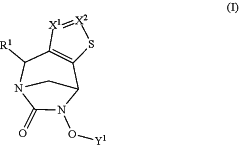| CPC A61K 31/551 (2013.01) [A61K 31/407 (2013.01); A61K 31/427 (2013.01); A61K 31/43 (2013.01); A61K 31/431 (2013.01); A61K 31/545 (2013.01); A61K 31/546 (2013.01); A61P 31/04 (2018.01); C07D 495/18 (2013.01); C07D 513/18 (2013.01)] | 17 Claims |
|
1. A compound of formula (I), in which:
 wherein:
R1 is chosen in the group consisting of H, C(═O)NR2R3;
n is an integer comprised between 1 and 6;
R2 and R3, identical or different, are chosen in the group consisting of H, linear or branched (C1-C6)alkyl optionally substituted by one or more R5;
R5 is C(═O)NH2;
Y1 is chosen in the group consisting of SO3H, CHFC(═O)Y2 and CF2C(═O)Y2, SO3(C1-C6)alkyl-C(═O)O(C1-C6)alkyl;
Y2 is chosen in the group consisting of OH, O(C1-C6)alkyl linear or branched, O(C3-C11)cycloalkyl, O-(4 to 6-membered)heterocyclyl comprising 1 or 2 heteroatom independently chosen in the group consisting of N, O and S;
NY3Y4, wherein the alkyl, cycloalkyl and heterocyclyl are optionally substituted by one or more Y5;
Y3 and Y4, each identical or different, is chosen in the group consisting of linear or branched (C1-C6)alkyl, linear or branched O(C1-C6)alkyl, (C3-C11)cycloalkyl, (4 to 6-membered)heterocyclyl comprising 1 or 2 heteroatoms independently chosen in the group consisting of N, O or S, or form together with the nitrogen atom to which they are linked a (4 to 6-membered)heterocyclyl comprising 1 or 2 heteroatoms independently chosen in the group consisting of N, O or S; wherein the alkyl, cycloalkyl and heterocyclyl is optionally substituted by one or more Y5;
Y5, each identical or different, is chosen in the group consisting of linear or branched (C1-C6)alkyl, (C3-C6)cycloalkyl, linear or branched O(C1-C6)alkyl, linear or branched O(C1-C6)alkyl-O(C1-C6)alkyl, linear or branched (C1-C6)alkyl-O(C1-C6)alkyl; and O(C3-C6)cycloalkyl;
X1=X2 is chosen in the group consisting of N═CX4, CX3═CA1 and CA1═CX4;
A1 is chosen in the group consisting of H and a halogen;
X3 and X4 is chosen in the group consisting of (CH2)m—C(═O)NX6X7, (CH2)n—NX6X7, (CH2)n—NX6C(═O)X7, (CH2)n—NHC(═NX6)NHX7, (CH2)m-(5- to 6-membered heteroaryl comprising from 1 to 4 heteroatom independently chosen in the group consisting of N, O, S), wherein the heteroaryl is substituted at least by one or more Z3;
m is an integer comprised between 0 and 6;
X6, X7 and X8, each identical or different, are chosen in the group consisting of H, linear or branched (C1-C6)alkyl-Z3;
Z1 and Z2, each identical or different are chosen in the group consisting of H, linear or branched (C1-C6)alkyl;
Z3, each identical or different, is chosen in the group consisting of (CH2)m—NZ1Z2, (CH2)m—NHC(═NH)NHZ1;
Z4 represents H or linear or branched (C1-C6)alkyl;
any sulphur atom present within a heterocycle can be oxidized to form a S═O group or a S(O)2 group;
any nitrogen atom present within a heterocycle or present within group wherein it is trisubstituted thus forming a tertiary amino group, can be further quaternized by a methyl group; or
a racemate, an enantiomer, a diastereoisomer, a geometric isomer or a pharmaceutically acceptable salt thereof, with the exception that if one of X3 or X4 represent (CH2)m—C(═O)NX6X7, or (CH2)n—NX6X7 then at least one of X6 or X7 is different from H.
|